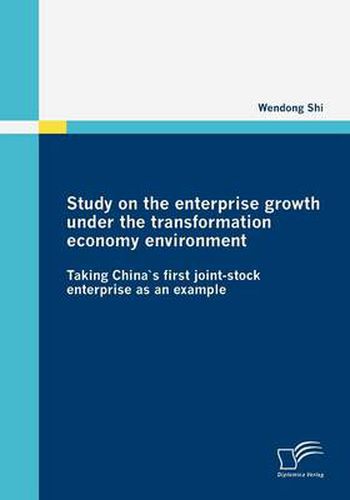Readings Newsletter
Become a Readings Member to make your shopping experience even easier.
Sign in or sign up for free!
You’re not far away from qualifying for FREE standard shipping within Australia
You’ve qualified for FREE standard shipping within Australia
The cart is loading…






This title is printed to order. This book may have been self-published. If so, we cannot guarantee the quality of the content. In the main most books will have gone through the editing process however some may not. We therefore suggest that you be aware of this before ordering this book. If in doubt check either the author or publisher’s details as we are unable to accept any returns unless they are faulty. Please contact us if you have any questions.
Since the end of the 1970s and the beginning of 1980s, with the political and economic system changes in the world, some enterprises being operated on the basis of market mechanism have emerged in the economy which once implemented the planning resource allocation (such as former Soviet Union, countries in eastern Europe and Mainland China, countries in Southeast Asia such as Vietnam). As the operation mode which complies with the market mechanism is adopted early in terms of the property right and operation mechanism, these enterprises grow rapidly under the loose regulation of the government and in the rapid development of the domestic market. However, with the competition intensified and the internationalization degree increased in the domestic market of the transitional economy, a large number of enterprises have suffered declined business, insolvency, bankruptcy or even winding-up since the 1990s. Some enterprises which grow rapidly in the 1980s are deep in the business operation crisis or even go bankrupt in the middle and later stage of 1990s. This is best demonstrated by the companies which are listed at Shenzhen Stock Exchange, Mainland China in the early stage. According to the report in International Finance News, March 6, 2002, 9 local listed companies in Shenzhen suffered losses in 2000, accounting for 9.38% of the total loss-incurring listed companies in the country in that year. Afterwards, the number of loss-incurring enterprises in 2001 increases to 12, accounting for 11.88% of the total listed companies in the country. In addition, according to the statistics of Shenzhen Stock Exchange, of the 9 loss-incurring local listed companies in Shenzhen in 2000, 6 of them undergo the system reform and are listed before 1993, and of the 12 loss-incurring local listed companies in Shenzhen in 2001, 7 of them undergo the system reform and are listed before 1993. In 2002, of the 67 A-share listed companies in Shenzhen, there are 8 ST companies, accounting for
$9.00 standard shipping within Australia
FREE standard shipping within Australia for orders over $100.00
Express & International shipping calculated at checkout
This title is printed to order. This book may have been self-published. If so, we cannot guarantee the quality of the content. In the main most books will have gone through the editing process however some may not. We therefore suggest that you be aware of this before ordering this book. If in doubt check either the author or publisher’s details as we are unable to accept any returns unless they are faulty. Please contact us if you have any questions.
Since the end of the 1970s and the beginning of 1980s, with the political and economic system changes in the world, some enterprises being operated on the basis of market mechanism have emerged in the economy which once implemented the planning resource allocation (such as former Soviet Union, countries in eastern Europe and Mainland China, countries in Southeast Asia such as Vietnam). As the operation mode which complies with the market mechanism is adopted early in terms of the property right and operation mechanism, these enterprises grow rapidly under the loose regulation of the government and in the rapid development of the domestic market. However, with the competition intensified and the internationalization degree increased in the domestic market of the transitional economy, a large number of enterprises have suffered declined business, insolvency, bankruptcy or even winding-up since the 1990s. Some enterprises which grow rapidly in the 1980s are deep in the business operation crisis or even go bankrupt in the middle and later stage of 1990s. This is best demonstrated by the companies which are listed at Shenzhen Stock Exchange, Mainland China in the early stage. According to the report in International Finance News, March 6, 2002, 9 local listed companies in Shenzhen suffered losses in 2000, accounting for 9.38% of the total loss-incurring listed companies in the country in that year. Afterwards, the number of loss-incurring enterprises in 2001 increases to 12, accounting for 11.88% of the total listed companies in the country. In addition, according to the statistics of Shenzhen Stock Exchange, of the 9 loss-incurring local listed companies in Shenzhen in 2000, 6 of them undergo the system reform and are listed before 1993, and of the 12 loss-incurring local listed companies in Shenzhen in 2001, 7 of them undergo the system reform and are listed before 1993. In 2002, of the 67 A-share listed companies in Shenzhen, there are 8 ST companies, accounting for